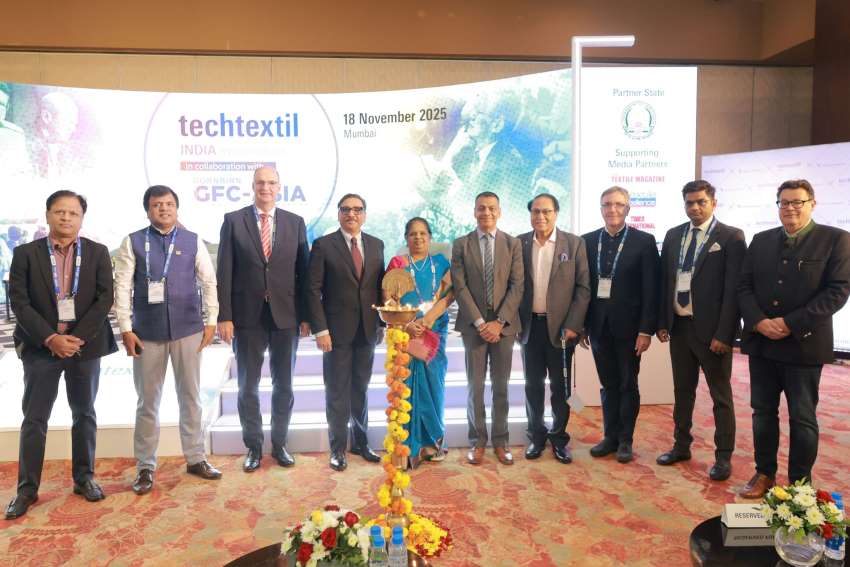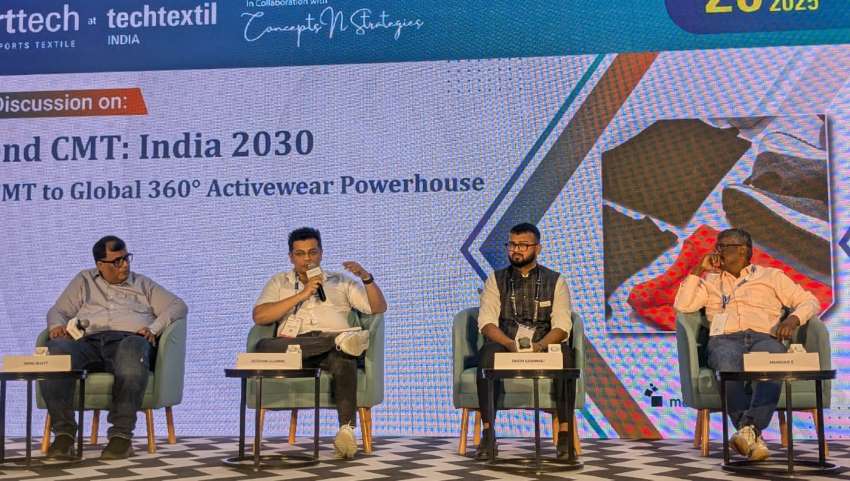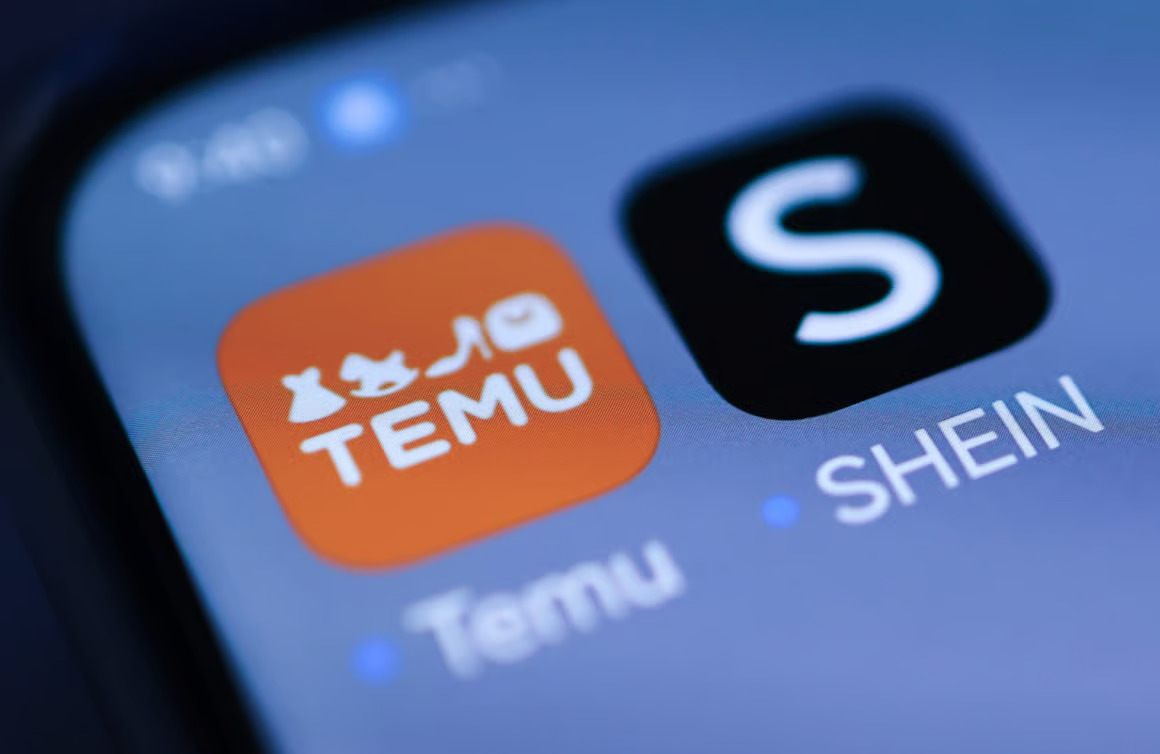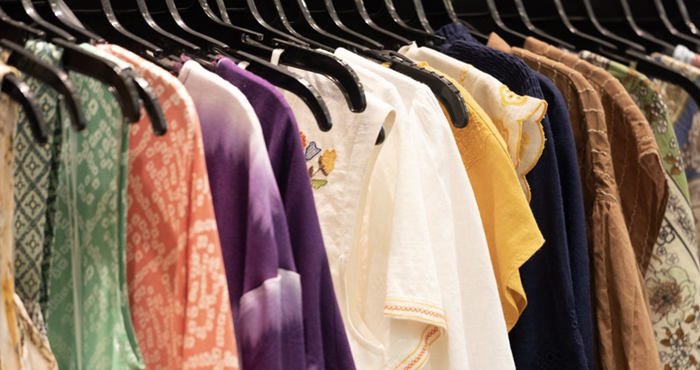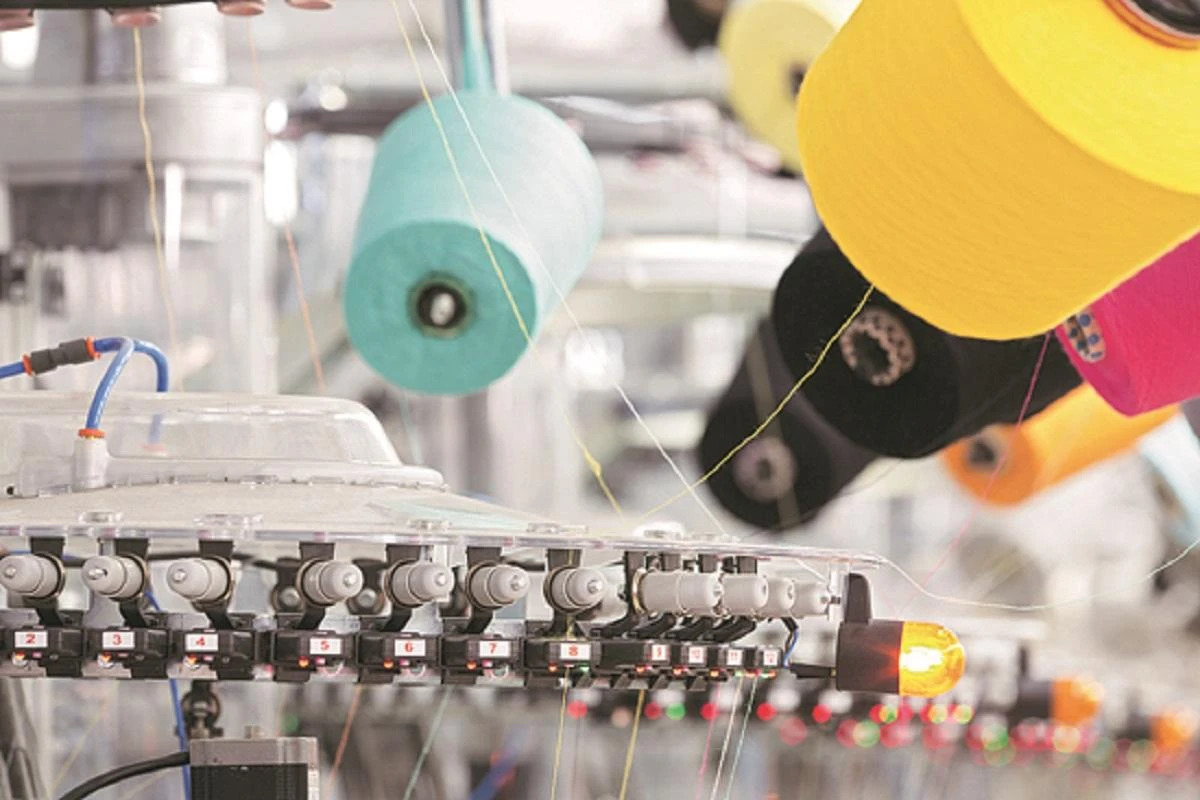FW
Valued at $ 5.2 billion in 2025, the global textile waste recycling market is estimated to grow consistently at a rate of 4.8 per cent CAGR until 2035, reaching the value of $8.7 billion.
As per a report by MarketGenics India, Asia Pacific dominates the share of the worldwide market at 62.0 per cent, with its revenues amounting to $3.2 billion, with China projecting the highest development at 6.2 per cent CAGR. These dynamics indicate a changing industrial emphasis on minimizing landfill waste and chemical use and increasing cost-effectiveness with green manufacturing.
Growing numbers of environmentally aware consumers and tough international policies such as Extended Producer Responsibility (EPR) are driving change, with brands being pushed to go sustainable. Governments around the globe are enacting tougher recycling legislation, and innovations like 100 per cent automatic textile waste sorting machines are coming forward to speed up recycling.
A global leader in specialty chemicals, Archroma has been honored with the International Textile Manufacturers Federation (ITMF) 2025 Sustainability & Innovation Award for its product, Denim Halo. This revolutionary denim pretreatment and dyeing process gives brands and mills a straightforward way to create the highly sought-after distressed denim look while significantly cutting down on environmental impact and utilizing cleaner chemistry.
Archroma believes in challenging the status quo. Under their planet-conscious roadmap, the brand seeks solutions that not only advance sustainability but also nurture the creativity and profitability of textile manufacturers, says Dhirendra Gautam, Vice President Commercial, Archroma.
While distressed denim has been a consumer favorite for decades and is more popular than ever, achieving the coveted worn and faded appearance has always been problematic. Traditional methods often involve manual scraping, the use of hazardous potassium permanganate sprays, or energy-intensive stone-washing. Conventional indigo and sulfur dyeing processes further contribute to the burden with high water and energy consumption and significant wastewater discharge.
Denim Halo offers a breakthrough alternative to these issues. The innovation is inspired by a unique new chemistry, Dirsol RD, and a broad portfolio of textile dyes developed through decades of advanced research to produce laser-friendly denim with outstanding contrast on intense black and indigo shades.
The core component, Dirsol RD p, is a new, patented viscosity-modifying pretreatment that enables superficial dyeing. This reduces water, energy, and greenhouse gas emissions in processing and wash-off. In the Denim Halo process, it is combined with a tailored Archroma dye solution according to the mill’s specific production needs.
The benefits of Denim Halo extend beyond sustainability to include significant gains in safety and economics for manufacturers. Mills can achieve distressed effects without changing standard dye recipes or existing equipment setups. The process enhances worker safety by enabling high-contrast laser etching, which eliminates the need for hazardous potassium permanganate and manual scraping. It reduces caustic soda consumption in sulfur mercerizing and requires less chemical use in dyeing and finishing. Besides, it also results in reduced yarn shrinkage and improved garment tensile strength, particularly on black denim, while enabling easier washdown.
The International Apparel Federation (IAF) has appointed Stefano Festa Marzotto as its new President. The announcement was made during the federation's annual convention held in Yogyakarta, Indonesia. Currently holding the position of Commercial Director, Miles Manifattura Spa, Marzotto steps into this significant global role to guide the apparel industry's premier organization.
During his tenure as the President, Marzotto is set to focus on addressing the complex issues facing the modern apparel sector. He plans to tackle these challenges with a steadfast determination and a spirit of deep collaboration with the IAF Board and the federation's management team.
The IAF serves as a powerful global organization, representing an enormous segment of the apparel industry. Its membership spans across countries and includes over 150,000 companies and a workforce of approximately 20 million employees.
The Federation aims to actively promote the development of supply chains that are smarter, stronger, and more sustainable across the entire apparel industry. Under Marzotto's leadership, the IAF is expected to intensify its efforts in driving innovation and responsible practices in manufacturing, sourcing, and logistics. His appointment is seen as a key step in furthering the IAF's commitment to a more ethical and efficient global textile and clothing sector.
The European Commission has proposed targeted measures and simplifications for the implementation of the EU Deforestation Regulation (EUDR) to reduce the administrative burden on certain companies and ensure the smooth function of the new IT system.
These proposed changes are currently being discussed by the European Parliament and the Council, but the key measures include:
The Commission's proposal focuses on streamlining requirements for actors further down the supply chain and for smaller primary producers.
Only the first operator placing a product on the EU market would be obliged to submit a Due Diligence Statement (DDS) into the EUDR IT system. This means downstream operators and traders (like retailers or manufacturers who process the product further) would no longer need to submit a separate DDS, significantly simplifying the process for them. They would still need to collect and pass on the reference numbers.
Micro and small primary operators from countries classified as low-risk would only need to submit a simple, one-off declaration into the IT system, replacing the need for regular, full DDS submissions. This primarily benefits small EU farmers and foresters.
To ensure the EUDR Information System can handle the anticipated load and to allow companies more time to prepare, the Commission proposed transitional periods.
For large and medium enterprises, the application date remains December 30, 2025. However, they will benefit from a six-month grace period for checks and enforcement, meaning enforcement measures would not begin until June 30, 2026.
For micro and small enterprises, the application date is postponed by one year, with obligations applying from December 30, 2026 (instead of the previously set June 30, 2026).
These targeted adjustments are designed to maintain the core objective of the EUDR—to keep products linked to deforestation off the EU market—while making compliance more manageable and efficient.
Global footwear, apparel, and accessories business Deckers Brands announced a 9.1 per cent Y-o-Y rise in net sales during Q2, FY26, powered by double-digit growth from its flagship brands, Hoka and Ugg. Despite the strong quarterly performance, the company's shares slipped after its full-fiscal 2026 sales forecast landed below analysts' predictions.
For the quarter ended September 30, Hoka's net sales increased by 11.1 per cent to $634.1 million, compared to $570.9 million a year prior. The net sales of Ugg's grew by 10.1 per cent to $759.6 million, compared to $689.9 million. In contrast, net sales for the company’s ‘other brands’ segment declined by 26.5 per cent to $37.2 million.
Overall wholesale net sales of Deckers Brands expanded by 13.4 per cent during the quarter while direct-to-customer (DTC) net sales contracted by 0.8 per cent. Regionally, international net sales increased sharply by 29.3 per cent, while domestic (U.S.) net sales decreased by 1.7 per cent. The company’s financial health improved slightly, with the gross margin rising to 56.2 per cent.
The double-digit growth delivered by Hoka and Ugg in the second quarter, reflects strong performance and international momentum for these brands, says Stefano Caroti, President and CEO, Deckers Brands’ Innovative products and a ‘best-in-class operating model enablesthe company to achieve its full-year outlook, he adds.
For the full FY26, Deckers Brands expects Hoka to grow by a ‘low-teens percentage’ and Ugg to grow by a ‘low-to-mid-single-digit percentage.’ The business projects its gross margin will be approximately 56 per cent and its operating margin will be around 21.5 per cent.
Calvin Klein has introduced a new clothing take-back and recycling program-Re-Calvin- in the United States to simplify the clothing disposal process for its US customers and reduce textile waste.
Launched by the PVH Corp-owned brand, this complimentary initiative helps customers extend the life of pre-loved apparel, shoes, and accessories - from any brand - through donation. Calvin Klein partnered with Trove, a leader in branded resale and customer trade-in, and Debrand, a sortation and circular logistics expert, to power the new program.
Re-Calvin stands out for accepting nearly all apparel categories, including notoriously difficult-to-recycle items like intimates, such as bras, swimwear, and underwear. The take-back program ensures used items are recycled, downcycled, or responsibly disposed of, only using waste-to-energy processes when other options aren't viable.
The program makes circularity more accessible to the brand’s customers and delivers alternative uses for pre-loved items, says David Savman, Global Brand President, Calvin Klein. US customers can participate by visiting calvinklein.us/re-calvin to print a free shipping label and mail in their items. Once received, items are processed according to Calvin Klein’s standards and routed through the Reuse, Recycling/Downcycling and Responsible Disposal pathways:
The Re-Calvin program is powered by Trove’s new Take-back Plug-In, a technology solution that integrates directly into Calvin Klein’s existing US website. This plug-in enables the brand to manage item intake, routing, and transparency at scale while supporting the multi-brand, complex categories accepted by Re-Calvin.
Re-Calvin marks the first implementation of Trove’s new Take-back Plug-In program, notes Terry Boyle, CEO, Trove. With this launch, Calvin Klein shows how technology can make responsible choices simple for every customer, accepting items from any brand and across all categories, including intimates, to help keep more textiles in circulation.
Calvin Klein joins other major retailers like Carhartt, Michael Kors, and Patagonia in utilizing Trove's expertise for their resale and circularity initiatives.
Bangladesh's RMG exports to the Netherlands increased by over 21.21 per cent to $2.08 billion in FY24-25 from $1.72 billion in the previous year. As per the Export Promotion Bureau, this substantial growth was primarily fueled by the strong performance of the country's apparel sector.
Within the apparel category, knitwear exports saw a steep rise of 31.69 per cent, reaching $1.21 billion, up from $926 million a year earlier. Woven garments also showed solid growth, increasing by 9.04 per cent to $879 million, compared to $797 million in FY2023–24.
Beyond clothing, other notable exports included textiles and used clothing ($50 million), footwear and related products ( $96.75 million), headgear ($7.35 million)
Exporters and analysts largely credit this sustained growth to several factors: improved product quality, better supply chain management, a greater focus on sustainable production, consistent timely delivery, and enhanced product diversification.
To maintain this current momentum, industry experts emphasize that Bangladesh needs to strategically pivot toward high-value sectors. This includes areas like pharmaceuticals, ICT services, and processed food exports.
Experts also highlighted the necessity of reducing dependence on garments to successfully expand the market in the Netherlands. They recommend exploring the high potential of the leather industry, while strictly ensuring compliance with international environmental and labor standards.
The Netherlands is a significant investor in Bangladesh. Data from the Bangladesh Bank shows, the country invested approximately $303 million in 2022, accounting for 8.7 per cent of Bangladesh’s total foreign direct investment (FDI).
In a development favorable to Bangladesh, a new tax treaty between the two nations now permits Bangladesh to impose a 10 per cent withholding tax on technology and service payments originating from the Netherlands.
The 3rd Myanmar International Textile & Machinery Fair is scheduled to be held over three days in December, according to an announcement from the Myanmar Garment Manufacturers Association (MGMA).
The event will run from December 5-7, 2025 at the Yangon Convention Centre (YCC) in Yangon. The fair aims to foster long-term economic relationships and explore cooperation opportunities between China and Myanmar in the textile and garment industries, as well as to strengthen ties between Myanmar and ASEAN member countries. Ultimately, the event aims to drive development within Myanmar’s vital garment sector.
The MGMA has confirmed that the exhibition will be a one-stop-shop showcasing essential products and materials for the garment industry. This includes a wide array of items such as textile products and machinery from both China and Myanmar, offerings from local MSMEs (Micro, Small, and Medium Enterprises) and Made in Myanmar products, sewing motors, textile accessories, and raw materials, clothing tags, pricing tags, printing and trim accessories, and printing and machinery for producing designs and patterns.
The fair will feature a robust schedule of side events including panel discussions on sector development, exhibitions of traditional Myanmar, Chinese, and ASEAN costumes, CMP (Cut-Make-Pack) and local brand fashion shows, dedicated business matching sessions for exhibitors, and various industry-related seminars.
Parvinder Kadyan, Managing Director, Aadi Sustainability Solutions and Chairman of the Global Alliance for Textiles Sustainability (GATS), has been named to the Meaningful Business 100 (MB100) for 2025.
The MB100 is a global initiative that recognizes 100 leaders annually who successfully blend profit and purpose to advance the UN Sustainable Development Goals (SDGs). The 2025 cohort features innovators from 39 countries who are transforming diverse industries, including circular economy, fashion, and climate tech.
Kadyan was recognized for his efforts in promoting sustainability and circularity with cost neutrality within India’s textile sector. Through GATS and the India Denim Deal Hub, he is uniting recyclers, mills, brands, and policymakers. This collaborative approach aims to prove that circularity can only succeed through collective action across the value chain.
His flagship initiative, Recyclr, is set to establish India’s first EPR-ready, zero-waste denim factory. This facility will feature full traceability and footprint mapping from textile waste all the way to finished jeans. The project serves as a clear model demonstrating how decarbonization can be integrated directly into a viable business case.
Kadyan’s inclusion in the MB100 is a significant moment for India's textile industry, highlighting that the nation is now leading the global movement for sustainable, circular, and equitable fashion, extending its strength beyond just manufacturing volume.
Sri Lanka's apparel exports saw modest year-over-year growth in September 2025, as per a report by the Joint Apparel Association Forum (JAAF). This rise was driven by stronger sales in the European Union (EU) and other markets, which compensated for declines in shipments to the United States (US) and the United Kingdom (UK).
While the monthly figures were lower than those for August, exports for September 2025 reached increased by 1.58 per cent to $403.01 million, compared to $396.73 million in September 2024. Exports to the US declined by 4.71 per cent while those to the UK lowered by 15.06 per cent.
Meanwhile exports to the EU increased by 10.75 per cent with shipments to other destinations rising by 19.49 per cent
Total apparel exports from January to September 2025 increased by 6.83 per cent to $3,798.25 million as against $3,555.54 million recorded during the same period in 2024.
Exports to the US grew by 1.73 per cent to $1,461.02 million. The EU (excluding the UK) recorded strong growth of 14.24 per cent, reaching $1,173.21 million. Exports to the UK rose by 2.31 per cent to $533.73 million while exports to other markets expanded by 10.45% to $630.29 million.
Demand in some traditional markets remains inconsistent, Sri Lankan exporters have shown ‘remarkable adaptability through efficiency, innovation, and market diversification, notes. JAAF. The positive cumulative growth highlights the strength and competitiveness of Sri Lanka’s apparel sector even amid global headwinds, states the association
The JAAF reaffirmed its commitment to collaborating with the Government of Sri Lanka and other industry stakeholders to align policies, support small and medium manufacturers, and maintain the industry's status as a reliable, ethical, and future-ready sourcing destination.



